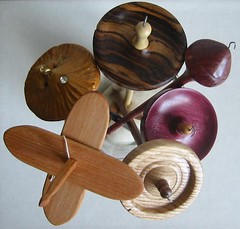 Advanced Drop Spindling earns you a Drop Spindle Ph. D.!
Advanced Drop Spindling earns you a Drop Spindle Ph. D.!If you've mastered your top or bottom whorl spindle and want to take it to the next level, this is the class for you! In this fun class we'll cover a variety of top whorl tricks, bottom whorl tricks, and handy techniques to get more out of your spindling: Andean plying, Peruvian wind-on, Kick-spinning, plying fine singles, Navajo plying, Bottom whorl speed-plying, and more!
Class length: 1/2 day
Materials provided ($8): basic top and bottom whorl spindles to spin with during class, wool roving.
Student bring: basic spindle-spinning skills (top or bottom whorl).
Spindles are available for purchase.
Taught: OFFF 2007.
Teaching next: NwRSA 2008.
Course Outline:
1. Spindle Physics
If it's a Ph. D., there has to be at least one lecture!
2. Top Whorl Spindles: Beyond the Basics
Many of these techniques are on ispindle.com
- No leader
- No notch
- Thigh roll
- Peruvian butterfly
- Balancing twist along last and current
- X wind-on (clockwise for singles, counter-clockwise for ply)
- Woolen and worsted (as seen in Spin-Off Winter 2005)
- Cop length and shaft length
- Overstuffing a spindle (wind-on tips)
- Andean book-bracelet (as seen on rosemaryknits.blogspot.com)
- Navajo ply
- Ply on the fly! (as seen on spindlers on Yahoo)
3. Bottom Whorl Turkish Spindles: Beyond the Basics
- No leader (no hook?)
- Half-hitch easy-on, easy-off
- Barberpole
- Finger-flick at thinnest point for max. speed
- Thigh roll
- Peruvian butterfly (same as top whorl)
- Turkish wind-on: X’s or 2-1
- Bottom whorl (non-Turkish) cop: X –wind on or cone.
- Speed Plying: twirling hand-roll
4. Spinning Fine Singles
- Drafting finer = finer singles
- Know your staple length
- Know your crimps — The thickness (wraps per inch) of the final ply should be twice the crimp, the final twists per inch should be the crimps per inch (Ann Fields, Spinning Wool: Beyond the Basics)
- More twist
- Well prepared fiber!
- Butterfly/bird hand-hold
- Ahka-style horizontal long-draw
- Plying fine singles—wind on a felt ball or into a tight ball; don’t use the Andean Plying Bracelet
- References:
How can I spin fine yarn? on Ask The Bellwether
Frog Hair and Hamster Floss on Fiber Life.
5. Silk Spindles
Silk requires a lot of twist to hang together. “Silk” spindles are spindles that spin very quickly, so the silk is twisted into yarn before it can put the “drop” in your drop spindle ;-) Silk also has a very long staple, so you can spin thread even on a 1 ounce silk spindle.
Silk spindle physics: center weight (heavy shaft, UFO– or bulb-shape whorl) == fast spin.
6. Ultralight Spindles
Any spindle under 1/2 ounce or 15 grams is an “ultralight” and can be used to spin frog hair, cobweb, or laceweight singles. My lightest spindle is 3 grams! The really light ones are best as “training” spindles — they will stop spinning the moment your yarn gets too thick — instant feedback! And they are too light to ply the thread they have created, unless you persist (because you add weight as you spin more onto the spindle!)
Make your own 7 gram spindle: the Lisard @ www.davidreedsmith.com
7. Mid whorl (Norge/Nahka) Spindles
Halla Nahkas are 1.5-2 ounces (great for worsted weight or plying).
Moving the whorl lower tends to give a more stable spin (less gyration)
Top whorl techniques apply here too.
If you want to thigh roll, build cop above whorl as is done for bottom-whorl spindles (X-wind-on or cone).
Ahka techniques can be applied to Norge spindles as well.
8. Balkan Spindles
This is basically a top-whorl spindle. Traditionally, the bottom whorl was removable, and was put on to ply—it adds weight; you would then get a repeatable size cop of yarn, built-up between the whorls. The two whorls give a more stable spin, as well.
There’s a great photo in the flickr group SpindleShots called Overloaded Spindle where she’s wound yarn below the lower whorl as well!
9. Collector Spindles
- Bobbin spindle (2 in existence?!)
- Niddy-spindle (thewoolery.com)
- Balinese spindle
- Italian flax spindle
- Top-whorl Turkish
***
For a complete list of classes from the Belle, see the class list.
For detailed descriptions of other classes see the class topic.
Not all classes have a detailed description; if you would like one for a class on the list, feel free to contact me with your request. Thanks!
